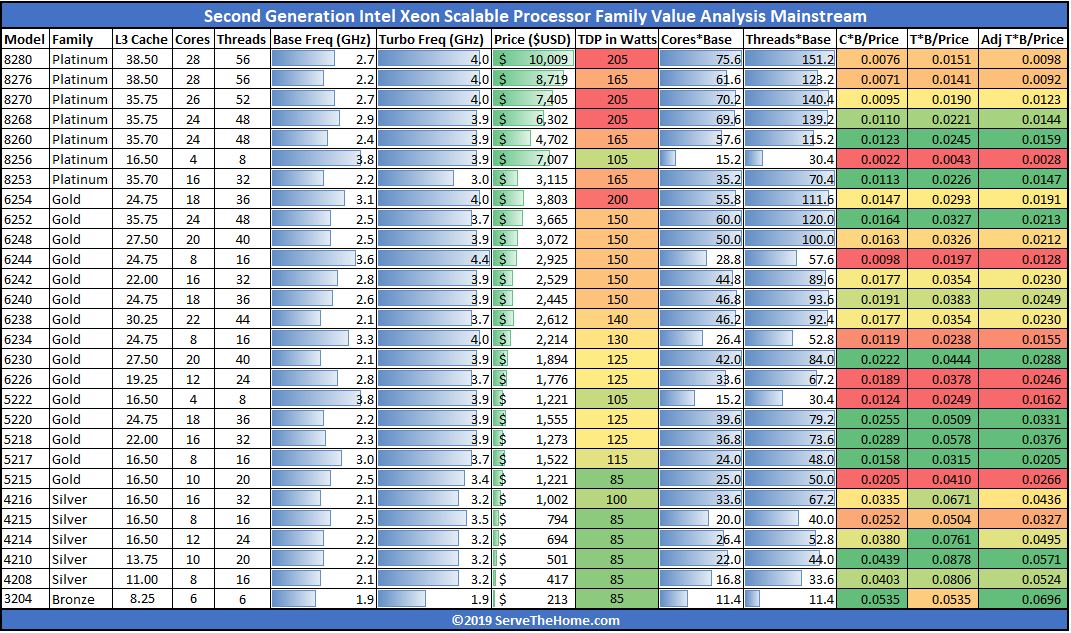Intel Xeon Platinum 8280 Market Positioning
Thes chips are not released in a vacuum instead, they have competition on both the Intel and AMD sides. When you purchase a server and select a CPU, it is important to see the value of a platform versus its competitors.
Intel Xeon Platinum 8280 v. Intel Alternatives
With 28 cores and high clock speeds, the Intel Xeon Platinum 8280 is a high-end part. It is also not the highest dollar per core part that Intel sells. Instead, Intel has chips designed with fewer cores and more cache and clock speeds for markets like per-core licensed databases. The Intel Xeon Platinum 8280 has high clock speeds, but it is not focused on the highest clocks in the lineup. Here is a chart from our Second Generation Intel Xeon Scalable SKU List and Value Analysis piece.

We saw a tangible benefit from upgrading over the Platinum 8276 to the Intel Xeon Platinum 8280. These CPUs are largely intended for quad and eight-socket designs instead of one and two-socket servers. We think Intel needs more mainstream 28 core designs. There are other custom parts but as for now, in the public SKU stack there are really only two parts at this level. By Q4 2018, 32 cores will be considered a midrange part by its competitors.
Intel Xeon Platinum 8280 v. AMD EPYC Alternatives
At the time of this writing, the current generation of AMD product is the AMD EPYC 7001 series. If you are looking at the Intel Xeon Platinum for quad or eight-socket servers, or with Intel Optane DCPMM, then AMD EPYC is not direct competition at the time of this writing.
The 2017 era “Naples” AMD EPYC generation EPYC 7601 is a solid performer. In most cases, the Intel Xeon Platinum 8280 will be faster. The Intel Xeon Platinum 8280 also is a single NUMA node design, but the current generation EPYC is less expensive and has more DRAM and I/O capacity. Those things matter.
This is about to change. 96 cores/ 192 threads will be in the upper end of the AMD EPYC “Rome” generation dual-socket design. AMD is about to flat out have more cores, by more than 2x. Intel will point to its Platinum 9200 series instead of this Intel Xeon Platinum 8280, but we showed why that is not valid in our Why the Intel Xeon Platinum 9200 Series Lacks Mainstream Support piece.
This quarter, AMD will have:
- More than twice the cores
- Significantly more memory bandwidth
- More PCIe lanes
- PCIe Gen4 that will double bandwidth per lane
- Top-end 64 core/ 128 thread (per socket) list pricing significantly lower than the Platinum 8280.
We covered the PCIe aspect in AMD EPYC Rome 2P Will Have 128-160 PCIe Gen4 Lanes. Still, this is a $10,000 list price chip that will be thoroughly outgunned in Q3 2019.
With that said, Intel has a better diversity of platforms. Even with vendors greatly expanding platforms for AMD EPYC “Rome”, Intel still will have more platforms in the market.
AMD is about to make the Intel Xeon Platinum 8280 untenable in single and dual-socket designs.
Intel Xeon Platinum 8280 v. Arm Alternatives
The Marvell ThunderX2 32 core parts are still competitive in many areas with the Intel Xeon Platinum 8280. Performance is good, and they are still 2017-era designs.
The drawbacks are simple. Going Arm means some servers that cannot directly migrate VMs which means IT departments have new compute silos. Likewise, code and binaries designed for x86 will not run natively on Arm servers.
Conversely, the Arm chips are vastly less expensive. If you need to run Arm servers for your IoT mobile development teams, Arm makes a lot of sense over the Platinum 8280. If you need to run your legacy VMs, it does not.
Final Words
With the Intel Xeon Platinum 8280 one realistically gets six main benefits:
- Slightly higher core and memory clock speeds
- Security mitigations
- Intel Optane DCPMM support
- Intel VNNI for AI inferencing
- Highest mainstream per-socket performance Intel currently offers
- Scalability to 4P and 8P servers
If those six items are not driving your purchasing decision, then we suggest looking elsewhere in the stack. If you do need top-end performance and the new features like Optane DCPMM support, then the Intel Xeon Platinum 8280 is simply the best you can get today.




Who gets these deep discounts on Intel CPUs? For example, Dell must buy the 8280 in bulk, but they sell it at retail for over $10k (at least for the 7920 workstation).
I’d like to know more about the avx differences between amd and intel.
I see that amd doubled to 256 bit. Do they have one or two execution units per core?
Also, since Cooper Lake has been sampling a while, should we also ask about AMD support for bfloat16? This will double the FP ai training FMAs per cycle for Cooper Lake vs Cascade Lake.
The ai training compute requirements are large, and doubling every 3.5 months according to some articles. Is that still true?